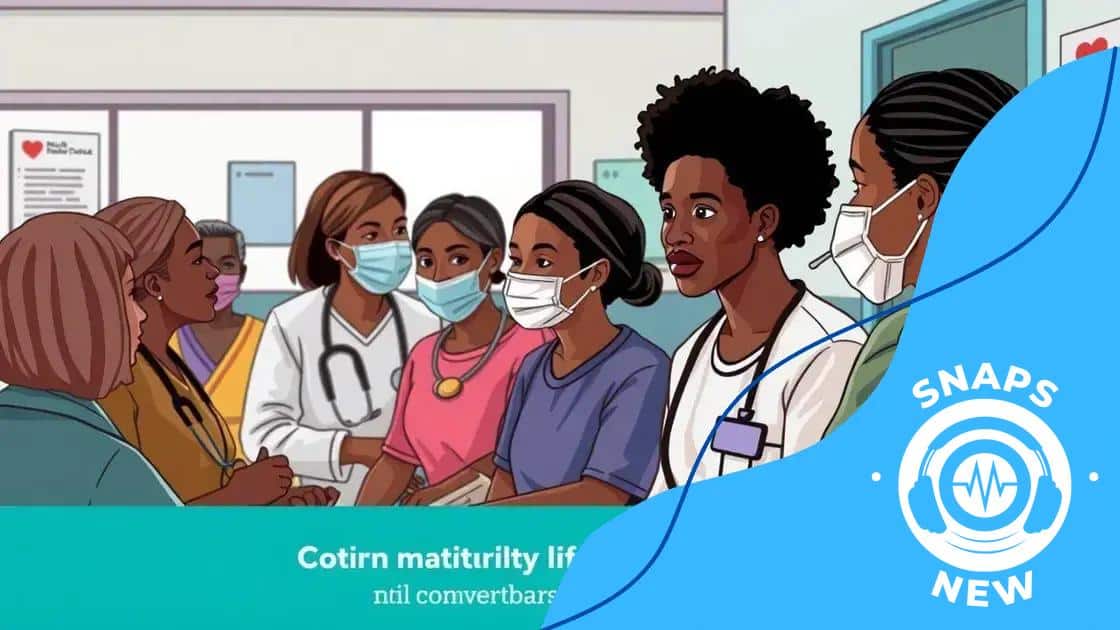The future of Medicaid expansion under new legislation

The future of Medicaid expansion under new legislation increases healthcare access for low-income individuals, presenting both challenges in funding and opportunities for improved service delivery through technology and community collaboration.
The future of Medicaid expansion under new legislation is shaping the landscape of healthcare in the United States. Are you curious about how these changes can affect you and your community? Let’s explore the details together.
Overview of Medicaid expansion
Overview of Medicaid expansion is vital for understanding shifts in healthcare policy. This expansion offers increased access to healthcare for many low-income individuals and families. It’s important to grasp how this initiative can change lives and improve health outcomes.
Key Features of Medicaid Expansion
The Medicaid expansion under the Affordable Care Act (ACA) presents several significant features that influence its implementation across states. Understanding these features can provide valuable insights into its overall impact.
- Eligibility increases to 138% of the federal poverty level.
- Federal funding covers most of the costs for new enrollees.
- States can decide whether to implement the expansion.
- Enhancements in preventive care and access to services.
These features allow states to gain more resources to manage their healthcare systems effectively. For example, with federal funding assistance, states can improve healthcare infrastructures and provide services to those who might otherwise remain uninsured.
Challenges and Implications
Despite the numerous benefits, there are challenges associated with Medicaid expansion. Some states have opted out, leading to disparities in access to care. This creates urgent questions about the overall effectiveness of the ACA and the future of universal healthcare coverage.
Addressing these challenges involves collaboration between state governments and healthcare providers. By working together, they can help bridge gaps and ensure that as many individuals as possible can access the care they need.
Key components of the new legislation
Understanding the key components of the new legislation is crucial for grasping how Medicaid expansion will affect healthcare access. This legislation is not just a simple update—it encompasses several significant changes aimed at improving healthcare delivery.
Core Elements of the Legislation
The new legislation includes important strategies intended to enhance Medicaid services and broaden coverage. These core elements work together to reshape the accessibility of healthcare for countless individuals.
- Expansion of eligibility to include more low-income individuals.
- Increased federal funding to support new enrollees.
- Emphasis on preventive care and mental health services.
- Provision for expanding telehealth services.
By integrating these elements, the legislation aims to ensure that more people receive essential healthcare services. Furthermore, it simplifies the enrollment process, making it easier for individuals to access Medicaid benefits.
Impacts on State Implementation
Each state has the choice to accept or reject the Medicaid expansion under this new law. States that opt in can expect a significant increase in federal match rates during the initial years. This means more resources to invest in local healthcare systems.
However, states that choose not to participate may see continued disparities in health coverage. As the implementation progresses, it will be vital to monitor how each state’s decision affects its residents.
Impacts on low-income populations

The impacts on low-income populations due to Medicaid expansion are profound and far-reaching. Understanding these effects helps highlight the importance of accessible healthcare for vulnerable groups.
Access to Healthcare Services
With the expansion of Medicaid, low-income individuals gain access to essential health services that they may have previously lacked. This includes preventive care, mental health services, and emergency care.
- Regular check-ups and screenings become more accessible.
- Individuals can receive treatment for chronic conditions.
- Increased access to mental health support.
- Reduced wait times for medical appointments.
Having these services available helps improve overall health outcomes, encouraging preventative measures that can lead to a healthier population.
Financial Relief for Families
Medicaid expansion also provides significant financial benefits to low-income families. Many families find themselves in challenging situations financially due to high medical costs. With Medicaid, these expenses decrease dramatically.
This financial relief allows families to redirect their resources towards other essential needs, such as housing and education. It contributes to economic stability, as families can focus on improving their lives without the burden of overwhelming medical debt.
Moreover, the emotional stress related to healthcare costs diminishes. When families know they have support, they can worry less about finances and concentrate on their well-being.
State responses to Medicaid changes
The state responses to Medicaid changes are diverse and significantly impact how healthcare is administered. Each state must decide how to implement the new legislation, leading to various approaches and outcomes.
Different Implementation Strategies
States are adopting different strategies based on their unique populations and political climates. Some states eagerly embraced Medicaid expansion, while others have been more cautious or resistant.
- States like California and New York rapidly expanded their programs, aiming to cover as many low-income residents as possible.
- Conversely, states such as Texas and Florida opted out of expansion, citing budgetary concerns and political opposition.
- Some states have introduced innovative models, such as managed care programs, to improve efficiency.
- In recent years, several states have requested waivers to tailor their Medicaid programs to better fit their needs.
These varied responses illustrate how local priorities influence healthcare delivery and access.
Political and Public Reactions
The public’s reaction to these Medicaid changes often mirrors the political landscape of each state. In states choosing expansion, many residents express support, believing increased access to healthcare is essential.
In contrast, in states resisting expansion, public opinion may reflect concerns over government spending or beliefs about personal responsibility. These attitudes play a significant role in shaping policymakers’ decisions and the overall success of the Medicaid program.
As states continue to navigate these changes, their experiences can offer valuable lessons for others. Observing how different approaches affect health outcomes can guide future healthcare reforms.
Future challenges and opportunities
The future challenges and opportunities surrounding Medicaid expansion are pivotal to shaping healthcare in the coming years. Understanding these dynamics can help stakeholders prepare for what lies ahead.
Key Challenges Ahead
As states implement Medicaid expansion, several challenges remain. These challenges can impact how successfully the initiatives function. One major concern is funding.
- Sustaining federal support as budgets tighten.
- Managing the increasing demand for services with limited resources.
- Addressing variations in state policies that may complicate expansion.
- Finding ways to decrease healthcare costs while maintaining quality.
These obstacles require strategic planning and adaptation to ensure that the needs of low-income populations are met.
Opportunities for Improvement
Despite challenges, Medicaid expansion presents numerous opportunities to enhance healthcare delivery and outcomes. By collaborating effectively, states can discover innovative solutions.
For instance, states can utilize technology to streamline enrollment processes and improve patient tracking systems. Emphasizing preventive care might reduce long-term costs, benefiting both patients and the healthcare system.
Furthermore, expanding healthcare access opens doors for greater health equity. By addressing disparities, communities can enjoy better health outcomes, overall satisfaction, and productivity. This not only improves the quality of life for individuals but can also enhance economic outcomes for entire regions.
FAQ – Frequently Asked Questions about Medicaid Expansion
What are the primary benefits of Medicaid expansion?
Medicaid expansion increases access to essential healthcare services for low-income individuals, improves health outcomes, and reduces the financial burden on families.
What challenges do states face in implementing Medicaid expansion?
States encounter challenges such as funding sustainability, managing increasing service demands, and addressing varying state policies affecting implementation.
How can technology improve Medicaid service delivery?
Technology can streamline enrollment processes, enhance patient tracking systems, and facilitate telehealth services, making healthcare more accessible.
What role do community collaborations play in Medicaid expansion?
Community collaborations are essential for addressing local healthcare needs, ensuring effective service delivery, and promoting health equity across populations.





